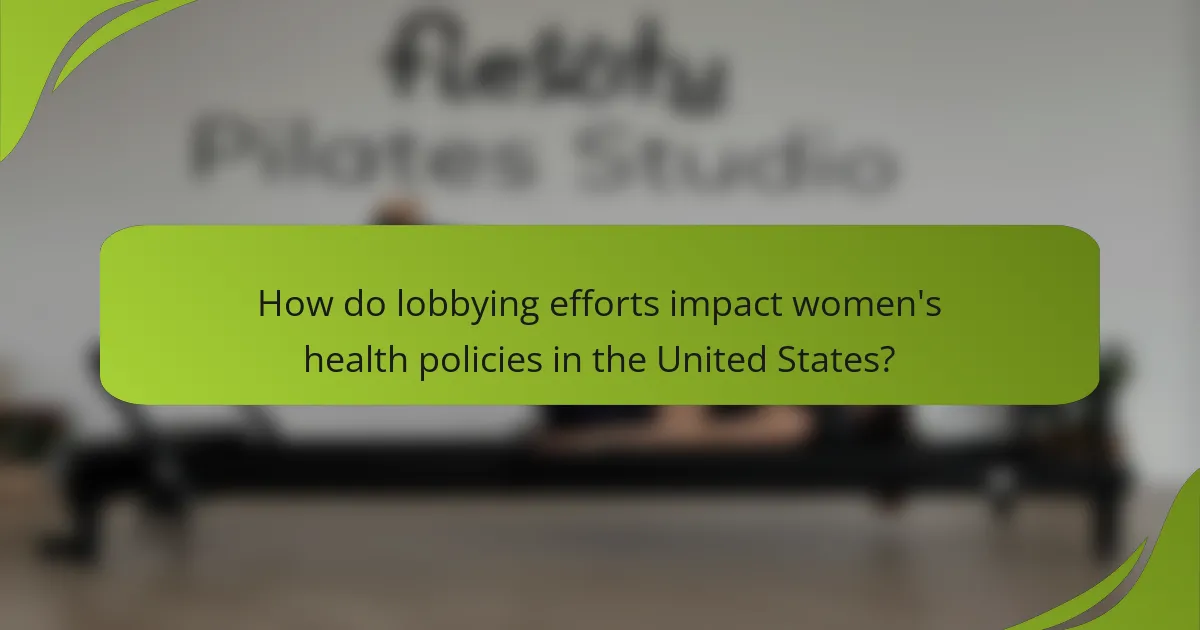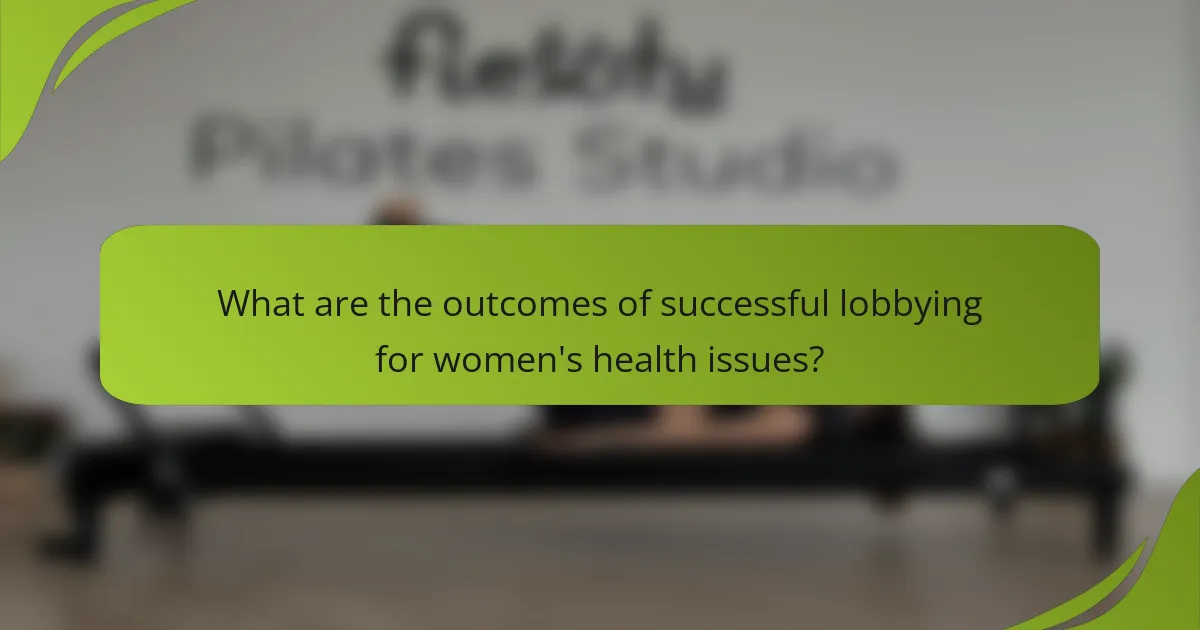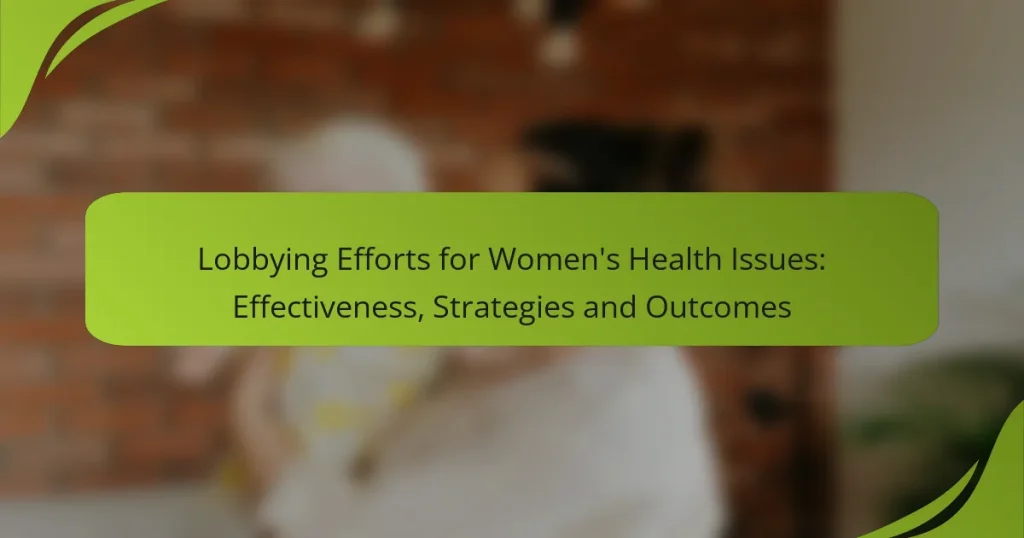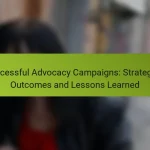Lobbying efforts for women’s health issues play a crucial role in shaping policies and improving healthcare access. By employing strategies such as grassroots mobilization and targeted advocacy campaigns, these initiatives effectively influence funding and legislative changes. The outcomes of successful lobbying not only enhance public awareness but also lead to significant improvements in the quality of care available to women.

What lobbying strategies are most effective for women’s health issues?
Effective lobbying strategies for women’s health issues include grassroots mobilization, coalition building, targeted advocacy campaigns, use of social media platforms, and engagement with policymakers. These approaches leverage community support, collective power, and strategic communication to influence health policies and funding.
Grassroots mobilization
Grassroots mobilization involves rallying community members to advocate for women’s health issues at local, state, or national levels. This strategy often includes organizing events, petitions, and demonstrations to raise awareness and demonstrate public support.
To maximize impact, grassroots efforts should focus on specific issues that resonate with the community, such as access to reproductive health services or maternal care. Engaging local leaders and influencers can amplify the message and encourage broader participation.
Coalition building
Coalition building brings together various organizations and stakeholders to create a unified front for women’s health advocacy. This strategy enhances credibility and increases resources, allowing for a more robust approach to lobbying efforts.
Successful coalitions often include healthcare providers, non-profits, and community groups that share common goals. Regular communication and collaboration among coalition members are essential for maintaining momentum and ensuring that all voices are heard.
Targeted advocacy campaigns
Targeted advocacy campaigns focus on specific legislative or policy changes related to women’s health. These campaigns often involve research, messaging, and outreach efforts tailored to particular decision-makers or legislative bodies.
Effective campaigns should include clear objectives, a defined timeline, and measurable outcomes. Utilizing data to support arguments and highlighting personal stories can make the campaign more relatable and persuasive to policymakers.
Use of social media platforms
Social media platforms are powerful tools for raising awareness and mobilizing support for women’s health issues. They allow advocates to share information quickly, engage with followers, and create viral campaigns that can reach a wider audience.
To leverage social media effectively, advocates should create compelling content, use relevant hashtags, and engage with influencers who can amplify their message. Regular updates and interactive posts can help maintain interest and encourage community involvement.
Engagement with policymakers
Engagement with policymakers is crucial for translating advocacy efforts into tangible health policy changes. This involves direct communication with legislators, attending public hearings, and participating in lobbying days to present the case for women’s health issues.
Building relationships with policymakers can lead to more effective advocacy. It is important to be prepared with clear, concise information and to follow up after meetings to reinforce the importance of the issues discussed.

How do lobbying efforts impact women’s health policies in the United States?
Lobbying efforts significantly influence women’s health policies in the United States by advocating for increased funding, legislative changes, and improved healthcare access. These efforts mobilize resources and public support to address critical health issues affecting women.
Increased funding for women’s health programs
Lobbying can lead to increased funding for women’s health programs by raising awareness among policymakers about specific health needs. Organizations often present data and personal stories to illustrate the importance of financial support for initiatives like reproductive health services, maternal care, and preventive screenings.
For instance, successful lobbying campaigns have resulted in millions of dollars allocated to programs such as the Title X Family Planning Program, which provides essential services to low-income women. These funds help ensure that women have access to necessary health resources.
Changes in legislation
Effective lobbying can result in significant legislative changes that enhance women’s health rights and protections. Advocacy groups work to influence lawmakers to pass bills that address issues such as reproductive rights, domestic violence, and workplace accommodations for pregnant women.
Recent examples include the introduction of laws that expand access to contraceptives and protect against discrimination in healthcare settings. These legislative changes often stem from persistent lobbying efforts that highlight the need for comprehensive women’s health policies.
Improved access to healthcare services
Lobbying efforts contribute to improved access to healthcare services for women by advocating for policies that eliminate barriers to care. This includes pushing for expanded Medicaid coverage, which has been crucial for many low-income women in accessing necessary health services.
Additionally, advocacy groups often work to ensure that healthcare providers receive training on women’s health issues, leading to better quality care. By focusing on equitable access, lobbying can help bridge gaps in healthcare availability, particularly in underserved communities.

What are the outcomes of successful lobbying for women’s health issues?
Successful lobbying for women’s health issues leads to significant improvements in healthcare policies, increased funding for research, and heightened public awareness. These outcomes collectively enhance the quality of care and resources available to women, ultimately contributing to better health outcomes.
Enhanced public awareness
One of the primary outcomes of effective lobbying is increased public awareness about women’s health issues. Campaigns often highlight critical topics such as reproductive rights, maternal health, and gender-specific diseases, leading to broader societal conversations.
For instance, lobbying efforts can result in media coverage that educates the public on issues like breast cancer screening or access to contraception. This heightened awareness can drive community support and influence policymakers to prioritize women’s health in legislative agendas.
Stronger healthcare regulations
Successful lobbying can lead to the establishment of stronger healthcare regulations that specifically address women’s health needs. This may include improved access to preventive care, mental health services, and reproductive health options.
For example, lobbying for comprehensive healthcare policies can result in mandates for insurance coverage of maternity care and preventive screenings. These regulations ensure that women receive necessary services without facing financial barriers, promoting overall health equity.
Increased representation of women’s health in research
Another significant outcome of lobbying is the increased representation of women’s health issues in medical research. Advocacy efforts can push for funding and resources to study conditions that disproportionately affect women, such as autoimmune diseases and reproductive health disorders.
By emphasizing the need for gender-specific research, lobbyists can influence grant allocations and encourage institutions to prioritize women’s health studies. This leads to better-informed healthcare practices and treatments tailored to women’s unique health needs.

What challenges do lobbyists face in advocating for women’s health?
Lobbyists advocating for women’s health encounter several significant challenges that can hinder their effectiveness. These include limited funding and resources, political opposition, and a lack of public interest, all of which can impede progress on critical health issues.
Limited funding and resources
Limited funding is a primary challenge for lobbyists in the women’s health sector. Many organizations rely on donations and grants, which can fluctuate and are often insufficient to support extensive lobbying efforts. As a result, they may struggle to maintain staff, conduct research, or launch awareness campaigns.
To overcome this, lobbyists should prioritize building partnerships with other organizations and seeking diverse funding sources. Collaborating with businesses or leveraging crowdfunding can help expand their financial base and increase their impact.
Political opposition
Political opposition poses a significant barrier to effective lobbying for women’s health issues. Different political agendas and party affiliations can lead to resistance against proposed policies or funding initiatives. This opposition can stem from ideological beliefs or a lack of understanding of women’s health needs.
To navigate this landscape, lobbyists should focus on building bipartisan support by framing issues in a way that appeals to a broader audience. Engaging with policymakers through education and presenting data-driven arguments can help mitigate opposition and foster collaboration.
Lack of public interest
A lack of public interest in women’s health issues can diminish the urgency and visibility of lobbying efforts. Many people may not be aware of specific health challenges or the importance of advocacy, leading to lower engagement and support for initiatives.
To address this, lobbyists should invest in public awareness campaigns that highlight the significance of women’s health. Utilizing social media, community events, and partnerships with influential figures can help raise awareness and generate public support, ultimately strengthening lobbying efforts.

What frameworks can guide effective lobbying for women’s health?
Effective lobbying for women’s health can be guided by frameworks that emphasize collaboration, evidence-based advocacy, and strategic communication. These frameworks help ensure that lobbying efforts are organized, targeted, and impactful, ultimately leading to better health outcomes for women.
Evidence-based advocacy
Evidence-based advocacy involves using research and data to support lobbying efforts. This approach requires gathering relevant statistics, studies, and expert opinions that highlight the importance of women’s health issues. For example, presenting data on maternal mortality rates can effectively persuade policymakers to prioritize maternal health initiatives.
To implement evidence-based advocacy, organizations should focus on compiling credible sources and tailoring messages to resonate with specific audiences. This may include creating infographics, policy briefs, or presentations that clearly communicate the urgency of the issues at hand.
Coalition building
Coalition building is crucial for amplifying lobbying efforts. By forming alliances with other organizations, stakeholders, and community groups, advocates can pool resources, share expertise, and strengthen their collective voice. This collaborative approach can enhance credibility and increase the likelihood of achieving policy changes.
When building coalitions, it’s essential to identify common goals and establish clear communication channels. Regular meetings and updates can help maintain momentum and ensure that all members are aligned in their lobbying strategies.
Strategic communication
Strategic communication is vital for effectively conveying messages to policymakers and the public. This involves crafting clear, concise, and compelling narratives that highlight the significance of women’s health issues. Utilizing various communication channels, such as social media, press releases, and community events, can help reach a broader audience.
Advocates should tailor their messages to different stakeholders, emphasizing the local impact of women’s health policies. For instance, discussing how improved access to reproductive health services can benefit families and communities can resonate more with local legislators.


